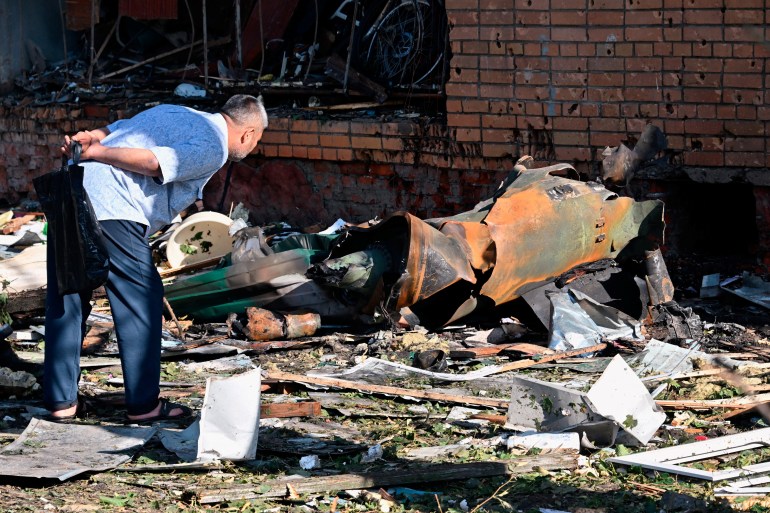Russia has asked thousands of its citizens to evacuate from Kursk and neighbouring Belgorod region, days after an unprecedented incursion on its territory by Ukrainian forces – the most significant cross-border attack since Moscow invaded Kyiv in February 2022.
On Saturday night, Ukrainian President Volodymyr Zelenskyy confirmed that his military was fighting inside Russian territory. The latest fighting has caused thousands of people to flee the border areas. Authorities have declared a “federal-level” state of emergency in the Russian regions of Kursk, Bryansk and Belgorod.
Keep reading
list of 4 itemsend of list
Russian President Vladimir Putin has called the incursion a “large-scale provocation” by Ukraine, which has been fighting Moscow forces in its eastern region.
Meanwhile, Ukraine and Russia have blamed each other for the outbreak of fire at the Zaporizhzhia nuclear plant, which remains under Russian control. The fire has since been put out.
Here’s more about the Kursk incursion and what it means for the war:
A man looks at debris near a multi-storey residential building, which according to local authorities was hit by remains of a destroyed Ukrainian missile, in Kursk on August 11, 2024. [Kommersant Photo/Anatoliy Zhdanov via Reuters]
When did Ukrainian troops enter Kursk?
Ukrainian forces launched the Kursk attack on August 6, taking Moscow by surprise. Fighting is under way between Kyiv and Moscow forces in the region.
“We are seeing the Ukrainian operation slowly expanding into neighbouring Belgorod,” said Alex Gatopoulos, Al Jazeera’s defence editor.
The Ukrainian army has taken some border villages in Belgorod, Gatopoulos said, adding that 11,000 people have been ordered to evacuate Belgorod region.
Ukrainian forces are around 30km (18.6 miles) inside Russia, according the Russian Ministry of Defence. The AFP news agency quoted a Ukrainian official as saying that thousands of Ukrainian troops are in Kursk.
Why did Ukraine decide to carry out such an attack, and what is Ukraine’s strategy?
The Ukrainian attack came after weeks of military setbacks in the eastern Donetsk region.
One of the reasons is “to seize the initiative”, Sean Bell, a retired fighter pilot and military analyst, said, explaining that there is a very long border between the two countries and “it’s evident that they can break through”.
Secondly, Ukraine’s move demonstrates that Russia does not control this war alone; “Ukraine is clearly taking the reins here,” Bell said.
Gatopoulos said Ukraine’s strategy with the Kursk attack amounted to a “drone Blitzkrieg” after Ukraine aggressively used first-person view drones that jammed the Russian drones. First-person-view drones are low-cost and usually operated using a screen or virtual reality goggles.
Where did the attack take place?
The attack took place in the town of Sudzha in Kursk located 530km (330 miles) from Moscow. Sudzha has the only pumping station that delivers Russian natural gas to Europe through Ukraine.
Kursk is in western Russia, at the border with Ukraine’s northeastern Sumy city.
How will the attack affect the Russia-Ukraine war?
The attack has raised questions on how Ukraine was able to attack Kursk so easily after two years of intense fighting.
Military analyst Bell told Al Jazeera that the attack can change the course of the war. While critics deemed Ukraine’s surprise attack reckless, “momentum and initiative is everything in warfare; this caught everybody off guard”, Bell explained.
The Ukrainian attack forced Russia to take troops from the front line, where they have been advancing to Ukraine’s Donetsk, and deploy them at Kursk, relieving pressure from the front line for Ukraine, Bell added.
To maintain its current position in Kursk, Ukraine will have to send more troops, tanks and resources, Gatopoulos said.
While there is a possibility that Russian forces will outnumber and defeat Ukraine, if Ukraine persists, “it would be a great bargaining chip in peace negotiations”, he said.
If the Ukrainian mission fails, “it will be a morale blow rather than a morale boost” for Kyiv, Gatopoulos said.
What has been Russia’s reaction?
Russia hit back militarily, deploying its own troops to quash the incursion. Additionally, Russian forces shot down 35 drones over the Kursk, Voronezh, Belgorod, Bryansk and Oryol regions on Sunday night.
Ukrainian officials said on Sunday that Russian air attacks killed five people including a four-year-old boy and his father just east of the Ukrainian capital Kyiv.
Russia has also evacuated civilians in border cities and declared a state of emergency in Kursk. The Russian state broadcaster said that 20 temporary accommodation centres were set up, airing footage of a tent camp in Kursk.
Officials from Russia have implied that the Ukraine attack had foreign backing.
“We have no doubt that the organisers and perpetrators of these crimes, including their foreign curators, will bear responsibility for them,” said Maria Zakharova, spokeswoman for the Russian Ministry of Foreign Affairs.
White House spokesperson Karine Jean-Pierre said on Wednesday that the United States was not made aware of Ukraine’s plans to attack Kursk.
Why is Belarus deploying forces to Ukraine border?
Belarus announced on Saturday that it was sending its forces to the border with Ukraine, claiming Ukraine violated Belarusian airspace during its Kursk incursion.
Belarus leader Alexander Lukashenko said Belarusian air defence forces destroyed thousands of Ukrainian targets flying over eastern Belarus’s Mogilev.
Viktor Khrenin, the country’s defence minister, announced that Ukraine’s violation of the Belarus airspace is indicative of a provocation and is “ready for retaliatory action”.
What happened at the Zaporizhzhia power plant?
On Sunday, Ukrainian official reported that a fire had broken out at the cooling tower of the Russian-occupied Zaporizhzhia power plant in southern Ukraine. The International Atomic Energy Agency (IAEA), the United Nations nuclear watchdog, said that the fire has not caused an impact on safety.
According to Russian state media, the fire has been extinguished.
Zelenskyy accused Russia of the fire, while Moscow blamed it on Kyiv.
“These reckless attacks endanger nuclear safety at the plant and increase the risk of a nuclear accident. They must stop now,” said Rafael Grossi, chief of IAEA in a statement, without blaming either side.
